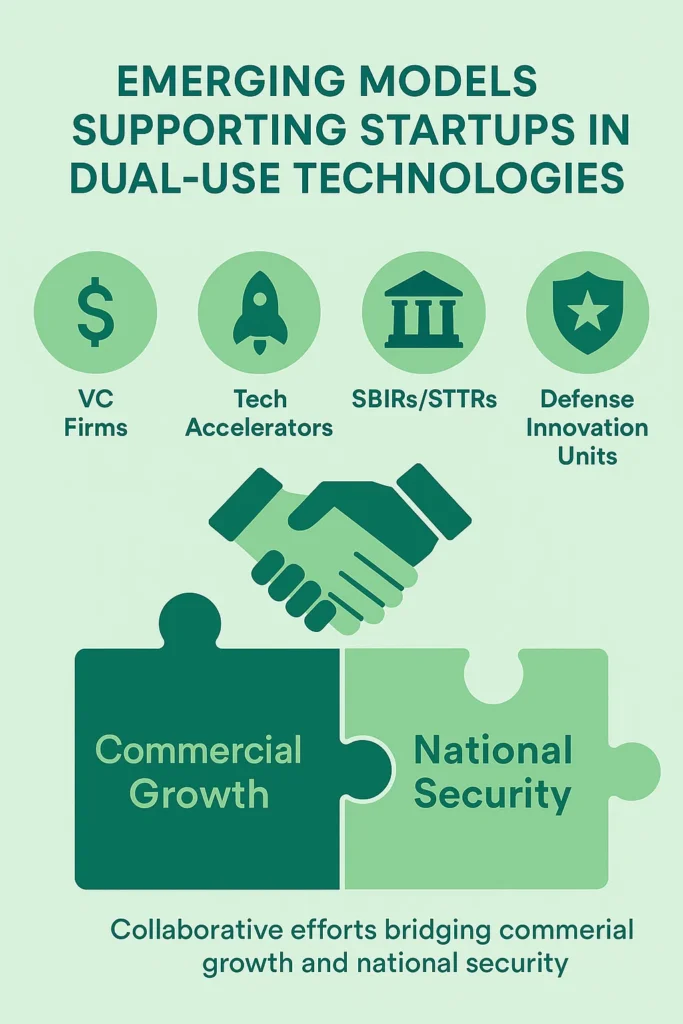In today’s geopolitical climate, the line between commercial and defense technology is vanishing. From AI and quantum computing to space systems and semiconductors, many of the world’s most disruptive technologies are now dual-use—capable of serving both civilian and military purposes.
For startups and researchers in these fields, that’s both an opportunity and a dilemma.
How do you fund and scale breakthrough tech that might attract defense interest—but still want to build a commercial company? What ethical, regulatory, and strategic choices must be made? And what does working with the U.S. Department of Defense (DoD) or intelligence community mean for your innovation roadmap?
What Is Dual-Use Technology?
Dual-use technology refers to scientific and engineering advancements that can be applied in both civilian and military contexts. Key dual-use categories in 2025 include:
Artificial Intelligence: Autonomous systems, computer vision, large language models
Quantum Technologies: Sensing, cryptography, and computing with security implications
Semiconductors: Advanced chips used in defense systems, satellites, and critical infrastructure
Clean Energy and Battery Tech: Portable power, grid resiliency, and field logistics
Cybersecurity and Communications: Secure comms, zero-trust networks, edge devices
Space Systems: Earth observation, propulsion, and resilient satellite networks
These innovations are at the heart of economic competitiveness—and national security.

The Dual-Use Opportunity for Startups
Defense engagement offers startups:
- Access to Early Non-Dilutive Capital: Through programs like AFWERX, DARPA, DIU, and Navy Agility Prime, startups can secure multi-million-dollar awards to mature dual-use tech.
- Pathways to Long-Term Government Contracts: A successful prototype with DoD can open doors to Phase III funding, Other Transaction Agreements (OTAs), and procurement opportunities.
- Increased Valuation and IP Protection: Startups with defense-grade tech are often seen as strategically valuable and resilient to market cycles.
- R&D Infrastructure: Working with national labs, test ranges, or DoD research centers allows startups to prove capabilities under extreme or mission-critical conditions.
The Dilemma: Commercial Vision vs. Government Reality
But dual-use also comes with trade-offs:
Mission Alignment: Founders must decide if they’re comfortable with potential military applications of their technology—and where they draw the line.
Export Controls: Technologies that fall under ITAR or EAR restrictions may face limitations on foreign investment, collaboration, or hiring.
IP and Data Rights: Government contracts often come with complex clauses regarding ownership of inventions and access to source code or technical data.
Long Procurement Cycles: Selling into the defense ecosystem requires patience, specialized contracting knowledge, and relationship-building across agencies.

Bridging the Gap: New Models Are Emerging
In 2025, more organizations are helping startups navigate the dual-use path:
- Venture Capital Funds with Defense Ties: VC firms like Shield Capital and Lux are blending commercial growth with national security outcomes.
- Technology Accelerators (e.g., NSIN, FedTech, MassChallenge Defense): These programs help commercial startups translate their tech into military use cases, pilot with defense partners, and access government mentors.
- Open Topic SBIRs and STTRs: Startups can propose their own solutions—aligned to DoD priorities—without needing a formal solicitation.
- Defense Innovation Units (DIU, AFWERX, etc.): Agencies now operate more like agile customers than traditional bureaucracies, offering clearer entry points for small tech firms.
How BridgePoint Labs Supports Dual-Use Innovators
At BridgePoint Labs, we guide early-stage companies, research labs, and spinouts through the complexities of dual-use development:
- Identify dual-use alignment for tech across space, cyber, AI, quantum, and more
- Craft non-dilutive funding strategies targeting DoD, DARPA, NASA, and intelligence community opportunities
- Help navigate compliance and regulatory frameworks like CMMC, ITAR/EAR, and SBIR data rights
- Build ethical alignment strategies for founders and investors balancing mission impact
- Provide support in establishing government partnerships, pitch decks, and defense-civilian dual narratives
Case Examples
- A space analytics startup used DIU and NASA funding to build a commercial + defense-ready orbital imaging platform
- A quantum sensing company secured dual-track Phase II SBIRs with both NSF and the Air Force
- A cybersecurity AI firm landed a $3M OTA agreement with the U.S. Army after BridgePoint helped them align their technology roadmap with C5ISR priorities
Key Takeaways
- Dual-use isn’t a niche—it’s now mainstream in frontier tech
- Startups can access unique funding, partnerships, and customers by engaging with defense innovation units
- But ethical clarity, regulatory compliance, and long-term vision are critical
- Success requires balancing commercial agility with mission-driven impact
Build with Purpose. Scale with Strategy
BridgePoint Labs helps founders chart a course through the dual-use landscape—maximizing opportunity while staying true to their mission. Whether you’re a CleanTech startup, space innovator, or AI researcher, we can help you align your vision with both the commercial market and the national interest.



